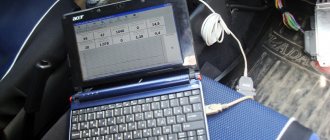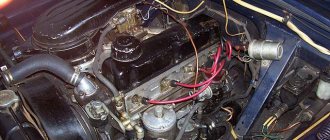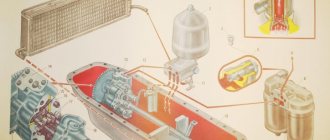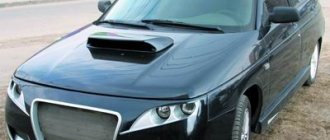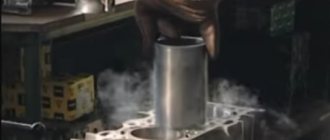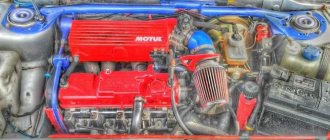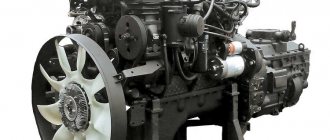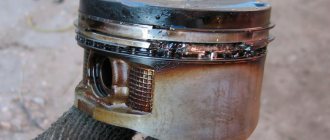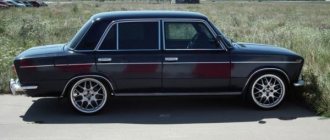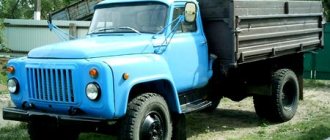History of the creation of ZMZ 409
The first samples of this engine began to be produced in 1996. ZMZ 409 is an improvement and development of the 406 motor model. In order to obtain a more powerful and dynamic engine, the diameter of the cylinder block on the ZMZ 405 was increased to 95.5 mm, due to this they were able to obtain an engine cylinder volume of 2465 cubic cm.
At ZMZ 409 they went even further; the volume of this engine was increased to 2.7 liters. This was achieved through certain design changes. Moreover, the cylinder block remained the same, it was taken from ZMZ 405. And in order to obtain a larger volume, the piston stroke distance was increased. This became possible thanks to the installation of a new crankshaft with larger cranks and a different piston design. The same connecting rods were used, with the same characteristics.
The design of the pistons has undergone minor changes. The hole for installing the pin was shifted upward, which gave an additional 4 mm of piston stroke, plus an additional 7 mm of crankshaft crank radius. All these measures made it possible to obtain a piston stroke of 94 mm, instead of the previous 86 mm.
The result was a new 409 engine with a displacement of 2693 millimeters. Based on the 409 engine, many modifications were created that are successfully produced today.
Technical characteristics of the internal combustion engine ZMZ 409
90.
| Name | Options |
| Compression, kgf/cm²: | 12. |
| Cylinder operating order: | 1→3→4→2. |
| Fuel supply system type: | with distributed fuel injection through electromagnetic injectors into the intake channels of the main engine. |
| Air filter part number: | 3160-1109080-11. |
| Oil filter part number: | 2105S-1012005-NK-2. |
| Oil pressure indicator part number: | MM-358. |
| Article number of the emergency oil pressure indicator sensor: | 30.3829. |
| Coolant: | Antifreeze "Lena" brands A40M, A65M. |
| CO volume (without radiator tank), l: | 3,6. |
| Thermostat part number: | TS107-05, TR-01. |
| Article number of the coolant temperature indicator sensor: | TM106-11. |
| Clutch: | dry, single-disc, with a diaphragm spring. |
| Generator part number: | 9422.3701 or 2502.3771, with current rectification unit and voltage regulator. |
| Starter part number: | 6012.3708 or 406.3708 (Iskra, Slovenia) or 0001 109 063 (BOSCH, Germany). |
| Ignition system: | with microprocessor controlled ignition timing. |
| Ignition coil brand: | 406.3705. |
| Spark plug part number: | A14DVR or LR17US. |
| Torque, Nm at 3900 rpm: | 219,5-245,2. |
| Direction of rotation of the HF (observing from the pulley side): | right. |
| Motor fuel: | Gasoline AI-92, 95. Along with gasoline for 409052.10, 409061. 10 is designed for operation on gas. |
| Fuel consumption per 100 km (city), l: | 11.5. |
| Oil consumption per 1000 km, g: | up to 100. |
| Weight without gearbox, kg: | 190. |
| Engine oil: | 5W 30-40, 10W 30-40, 15W-40, 20W-40. |
| Oil system volume, l: | 7. |
| The oil change is carried out after, km: | 7000. |
| When replacing, fill in, l: | 6. |
| Operating temperature, °C: | |
| Resource, km | |
| According to the manual: | 150. |
| In fact: | 250+. |
Comparative characteristics of modifications of the ZMZ 409 engine
| 409051.10/ 409052.10 | 40906. 10 | 40905. 10 | 409061. 10 | 40911. 10 |
| Benzine new / Gasoline zine | Benzy is new | Gasobenzine | Benzy is new | |
| Working volume, l | ||||
| 2,693 | ||||
| Diam. cylinders, mm | ||||
| 95,5 | ||||
| Piston stroke, mm | ||||
| 94 | ||||
| Power at 5000 rpm, hp | ||||
| 160,0 | 142.8 at 4600 rpm | 125 | ||
| Max. torque at 4000 rpm, Nm | ||||
| 245,2 | 230 at 3900 rpm (4000 rpm for ZMZ-40905.10) | 219,5 | ||
| Compression ratio | ||||
| 9,8 | 9.1 | 9.0 | ||
| Ek. Euro class | ||||
| 5 | 4 (5) | 4 | 5 | 4 (5) |
| Application | ||||
| UAZ: Pro, Patriot, Cargo, Pickup, Hunter. Patriot: Life Style; Expedition | UAZ: Patriot, Pickup, Cargo | UAZ: Hunter, Hunter Expedition | BAW-33462-102, Gazelle | UAZ: 741, 909, 962, 3303, 2206 |
| Basic data for adjustment and control of ZMZ 409 | |
| Oil pressure in a heated internal combustion engine at 850±50 rpm, kgf/cm², not less than: | 1,0 |
| Deflection of the drive belt is auxiliary. units when pressed with a force of 8 kgf, mm: | 14 ± 1 |
| Spark plug gap, mm: | 0,7…0,85 |
| Operating coolant temperature, °C: | 80…90 |
| Min. HF rotation speed at idle, rpm: | 850 ± 50 |
Possible breakdowns of ZMZ 409 during operation
| Breakdowns | |
| Possible causes of breakdowns | What to do |
| The engine won't start | |
| Gasoline supply problem | |
| - failure of the electric fuel pump (EFP): | Check the condition of the fuse. Check the serviceability and reliability of the EBN connectors, the PR relay and the EBN relay. When turning the key while turning on. ignition, the sound of the electric fuel pump should be heard within 2...3 seconds. |
| -reducing valve failure: | Replace. |
| -dirty filter: | |
| -no gasoline in the tank: | Refuel. |
| breakdowns in the ignition system | |
| - no contact in the electrical circuit of the ignition coils, control unit: | Check the condition of the connectors. |
| - failure of the ignition coil(s): | Replace. |
| The motor is unstable | |
| -water got into the fuel tank: | Drain the sediment from the tank. |
| - air leaks through leaks in the intake system, crankcase ventilation system and XX regulator: | Check the status of connections. Correct the defect. |
| Interruptions or failure of one of the cylinders. | |
| - carbon deposits on the heat cone of the candle: | Clean off the carbon deposits. |
| - spark plug failure: | Identify the faulty spark plug and replace it. |
| -the injector does not work: | Check the connector on the injector or replace the injector. |
| - spark plug breakdown: | Replace the candle holder. |
| - oil got into the spark plug socket: | Replace the seal under the valve cover |
| -ignition coil failure: | Replace. |
| Increased crankshaft rotation speed in idle mode when the internal combustion engine is warm | |
| - leaks in the connections of the hoses of the ventilation systems and the XX regulator: | Eliminate distortions in the hoses and tighten the clamps. |
| - the contact has disappeared or the XX regulator has failed: | Check the plug connections, replace the IAC. |
| - contact is lost or sensors have failed: | Check the connectors, replace the defective sensor. |
| Increased exhaust smoke | |
| - timing valves do not provide tightness: | Lather the valves. |
| - the valve stem seals are worn out: | Replace the caps. |
| - CPG wear: | Engine repair needed. |
| - contact failure or malfunction of the engine temperature sensor: | Check the presence of contact in the plug connection, replace the sensor. |
| The engine does not produce full power | |
| -dirty (cardboard) air filter element: | Replace. |
| - fuel filter is clogged: | |
| - electric fuel pump failure: | |
| - the throttle valves do not open completely: | Adjust the drive. |
| The internal combustion engine is overheating | |
| -little coolant in CO: | Add coolant. Make sure the system is tight. |
| - Thermostat failed: | Replace. |
| - the auxiliary drive belt is loose: | Adjust the belt tension. |
| Low oil pressure | |
| -reducing valve jammed: | Eliminate the cause of the wedge. |
| - the pressure reducing valve spring has weakened: | Replace the spring. |
| - failure of the oil pressure sensor or indicator: | Verify that the sensor or gauge has failed using another gauge. Replace the defective device. |
| - ICE overheating: | Eliminate the cause of overheating. |
| - wear of the oil pump: | Replace the oil pump. |
| -wear of HF liners: | Engine repair needed. |
| -too much or little oil in the oil sump: | Adjust the oil level (based on the dipstick). |
| Maslozhor | |
| - wear, sinking of piston rings: | Engine repair needed. |
| - failure of the crankcase ventilation system: | Wash the ventilation system parts. |
| - oil seals are destroyed: | Replace. |
| -oil leakage through seals and gaskets: | Fix leaks. |
| something is knocking in the engine | |
| -wear of HF liners: | Engine repair needed. |
| - wear of the ShPG: | |
| - malfunction of hydraulic pushers: | Replace. |
| - hydraulic chain tensioner failure: | |
| - failure of one of the valve springs: | |
A number of modifications of the 409 internal combustion engine
ZMZ 409 refers to engines that have a wide range of modifications that were installed on different brands of UAZ and Volga:
ZMZ 409.10
The first one is also the main engine ZMZ 409.10. This is a simple engine with standard firmware. This power unit has a capacity of 143 hp. Compliance with European requirements for emissions of harmful substances, Euro 2. This modification was installed on all UAZ models produced at that time.
ZMZ 40904.10
ZMZ 40904.10 - engine identical to the main motor. But this is a more modern engine that meets European standards Euro 3. The electronic program slightly stifled the engine power. On this engine it is equal to 128 hp. New gaskets, a new CPG, and a pressure sensor are installed here. ZMZ 40904.10 was installed mainly on: UAZ Hunter, UAZ Cargo, UAZ Patriot.
ZMZ 40905.10
ZMZ 40905.10, an identical version of the previous model, but with higher requirements for compliance with environmental standards for emissions of harmful substances. This engine had the same power of 128 hp, and complied with Euro 4. It drove the transmission of such UAZ cars: Cargo, Hunter, Pickup and Patriot.
4091.10
The derated version of the 40904.10 model is represented by the engine - ZMZ 4091.10. This engine is installed on UAZ loaves, its power is 112 hp. On the 4091.10 model, different camshafts and a new receiver are installed in the cylinder head. Its firmware complies with European environmental standards Euro 3.
ZMZ 40911.10
ZMZ 40911.10 - motor identical to the previous engine. It is used on UAZ loaves and has the same power. But the presence of DBP allows it to comply with Euro 4.
ZMZ 4092.10
The ZMZ 4092.10 engine was produced in small, non-serial batches. It had maximum power, for the 409 series of engines - 160 hp. This engine was the heart of passenger cars from the Gorky plant - GAZ Volga.
Engine malfunctions and repairs Patriot / Bukhanka / Hunter ZMZ-409
The ZMZ-409 engine was created on the basis of the 406 engine, or more precisely, on the basis of its successor ZMZ-405. A 405 block is used (the height of all blocks 405, 406, 409 is the same), a crankshaft with an increased stroke (from 86mm to 94mm), the connecting rods remain old, the pistons are changed, offset by 4mm. That's it, it was 405, it became 409, get your signature.
Modifications of the ZMZ 409 engine
1. ZMZ 409.10 - the main motor, complies with the Euro-2 environmental standard. Power 143 hp 2. ZMZ 40904.10 - analogue of 409.10 with a new CPG, new gaskets, DBP, complies with the Euro-3 environmental standard. Power 128 hp Installed on Patriot, Hunter, Pickup, Cargo. 3. ZMZ 40905.10 - analogue to 40904.10, compliance with the Euro-4 environmental standard. Power 128 hp Installed on Patriot, Hunter, Pickup, Cargo. 4. ZMZ 4091.10 - derated low-end version of ZMZ 40904.10, another receiver, camshafts (lift 8, phase 240), firmware, complies with Euro-3 environmental standard. Used on UAZ loaves. Power 112 hp 5. ZMZ 40911.10 - analogue of ZMZ 4091.10, DAD, meets the Euro-4 environmental standard. Used on UAZ loaves. Power 112 hp 6. ZMZ 4092.10 - non-serial motor. Power 160 hp Used on the Volga.
Malfunctions of ZMZ 409 engines
Due to the fact that the design of the motor is similar to ZMZ-406 and ZMZ-405, the problems are similar; the faults can be found HERE.
Technical data ZMZ 409
Four-stroke, gasoline engine, the four cylinders of which are arranged in one row, longitudinally located in the engine compartment.
The ZMZ 409 has been produced at the Zavolzhsky Automobile Plant since 2001; engine production continues successfully today.
- The cylinder block is made of high-strength cast iron, exactly the same block is used on the ZMZ 405.
- The exact volume of the cylinders is 2693 cubic centimeters.
- Power supply system 409 model distributed fuel injection, injector.
- The internal combustion engine gas distribution system is DOHC, two gas camshafts on which 16 valves are installed. One shaft is responsible for the intake of the combustible mixture, the other for the exhaust gases.
- This engine has almost the same piston stroke as the cylinder diameter of 94 and 95.5 mm, respectively. The compression ratio of the combustion chamber is 9:1.
- Engine power can be different, depending on the engine modification, at 4400 rpm, min., 112, 128 and 143 hp., hp. Torque at 3900 rpm, depending on engine modification from 210 to 230 Nm.
- Environmental standards of European compliance Euro 2, Euro 3, Euro 4.
- The weight of the power plant is 190 kilograms.
Characteristics of the ZMZ-409 engine
| Production | ZMZ |
| Engine make | ZMZ-409 |
| Years of manufacture | 2001-present day |
| Cylinder block material | cast iron |
| Supply system | injector |
| Type | in-line |
| Number of cylinders | 4 |
| Valves per cylinder | 4 |
| Piston stroke, mm | 94 |
| Cylinder diameter, mm | 95.5 |
| Compression ratio | 9 |
| Engine capacity, cc | 2693 |
| Engine power, hp/rpm | 112-143/4400 |
| Torque, Nm/rpm | 210-230/3900 |
| Fuel | 92 |
| Environmental standards | Euro 3 |
| Engine weight, kg | 190 |
| Fuel consumption, l/100 km - city - highway - mixed. | — 11.5 — |
| Oil consumption, g/1000 km | up to 100 |
| Engine oil | 5W-30 5W-40 10W-30 10W-40 15W-40 20W-40 |
| How much oil is in the engine | 7 |
| Oil change carried out, km | 7000 |
| Engine operating temperature, degrees. | ~90 |
| Engine life, thousand km - according to the plant - in practice | 150 300+ |
| Tuning - potential - without loss of resource | n.d. up to 200 |
| The engine was installed | UAZ Bars UAZ Bukhanka UAZ Patriot UAZ HunterUAZ Pickup UAZ Cargo UAZ Simbir |
Description of the features of ZMZ 409
This motor has a simple and reliable design. A significant feature is the durable cast iron block into which the cylinders are bored directly. Between the cylinders there are channels for heat transfer and a cooling system.
A distinctive feature of the 409 engine is the many modifications based on this engine. Initially, it was planned to install a variety of attachments on the internal combustion engine. The BC for all modifications was common, so it contained various channels, multiple technological holes, and threaded wells necessary for different models of the 409 engine. That is, on each block that came off the assembly line, it was possible to assemble any modification of the 409 motor.
The cylinder head is cast from especially durable aluminum and contains valves: 8 valves for the intake of the combustible mixture and 8 valves for the release of exhaust gases. Each cylinder has 4 valves, 2 exhaust and 2 intake valves. To adjust the valve clearances, hydraulic pushers are installed. They often broke on the first models. The reason was poor quality plastic shoes designed to tension the timing chain. When worn, the wear waste from the shoes contaminated the oil. Subsequently, the shoes were replaced with metal sprockets. The problem of rapid failure of valve clearance adjusters has been finally resolved.
The pistons of the 409 internal combustion engine are made of aluminum and are equipped with thermoregulatory inserts. There are special grooves at the bottom of the pistons; they prevent destruction of the pistons and valves when they meet in the engine, in the event of failure of the timing drive system. It must be remembered that the pistons, with the same diameter, of 405 and 409 engines cannot be replaced. They cannot be installed from one engine to another. The thing is that to increase the piston stroke in order to obtain the required volume of the internal combustion engine, the pin axis was shifted by 4 millimeters. Piston rings, as usual, have a quantity of 3 pieces. Compression rings are sprayed with porous chromium. The bottom ring is protected by a thin layer of tin.
The ZMZ 409 crankshaft is made of cast iron for strength. On this model, the crankshaft has a distinctive feature: its crank mechanism, together with the offset axial hole for the pin, provides a piston stroke of 94 cm, which is significantly more than that of the 406 and 405 models. The difference is 18 millimeters.
Other components, mechanisms and systems are borrowed from ZMZ 405 and differ slightly, depending on the modification of the 409 model.
Specifications
The technical characteristics of the engine for the UAZ Patriot car are given in the table below.
| Parameter | Meaning |
| Type | Row |
| Metal manufacturing BC | Cast iron |
| Nutrition | Injection |
| Piston stroke in mm | 94 |
| Cylinder diameter in mm | 95,5 |
| Compression | 9 |
| Volume in liters | 2,7 |
| Engine weight | 190 kg |
| Fuel consumption | 11.5 liters per 100 km in the city |
| Fuel type | Petrol |
| Gasoline brand | AI 92 |
| Engine life | 150 thousand km |
Attention! There are several engine modifications for the UAZ Patriot. They differ from each other in technical parameters. For example, ZMZ 40911.10 complies with Euro 4 environmental standards. The table shows the parameters of the base engine on the UAZ Patriot.
Many novice car owners want to know how much oil is in the engine, as they are afraid of underfilling or, conversely, overfilling. We will examine this question and some others in the following blocks, devoted to the design and operation of the 409 engine on the UAZ Patriot.
ICE design
Judging by the characteristics given in the table above, our ZMZ 409 engine is powered by an injector, and not by a carburetor. This improved the properties of the UAZ engine several times. Since now it is not a mechanical device that is responsible for supplying the fuel and lubricant mixture, but the electronic brain of the motor. The engine does not stall as mercilessly as the versions of the 400 series power unit, which were controlled using a carburetor.
The engine itself has an in-line arrangement of cylinders. And the block in which they are located and work is made of cast iron. In total, the UAZ Patriot engine has 4 cylinders and 16 valves.
Similar article Technical characteristics of the OM 904 Mercedes Benz engine
The cylinders operate strictly according to the 1-3-4-2 scheme. The crankshaft rotates to the right. Special channels are created between the cylinders through which coolant flows. The cylinder engine is not at risk of overheating because the cooling system is located throughout the engine and prevents it from overheating even in the most extreme situations.
The engine design is fully adjusted to the attachments. It contains a complete set of lubrication channels, which makes the power unit parts work longer. Although the manufacturer set the lifespan of the UAZ engine to 150 thousand kilometers, in practice it can withstand much more. With proper care, the engine from a UAZ Patriot can travel up to half a million kilometers without major repairs.
The bearing caps on the supports are not replaceable. The cylinder head is cast from aluminum alloy. It houses the valves, with four valves installed on each cylinder.
The exhaust valves are located on the left, and the intake valves on the right. The engine is equipped with a hydraulic pusher system. This allowed car owners to avoid constant adjustment of valve thermal clearances. In the latest versions of UAZ Patriot engines, thermal clearances are regulated by the computer brain of the engine.
The pistons of the 409 engine are made of aluminum. They have temperature-regulating inserts. And the grooves on the bottom of the piston protect these parts from impacts. Thanks to this innovation, the pistons can outlive the engine itself and be used as replacement parts on another engine.
The UAZ Patriot engine has two compression rings and one oil scraper ring. The top of the compression ring is coated with chrome, and the bottom is sprayed with tin.
The UAZ crankshaft is made entirely of cast iron. There are five counterweights and supports on it. The tail part and the nose part near the crankshaft are equipped with rubber seals. The washers that are located on the crankshaft prevent its movement along the axis.
Experienced mechanics recommend pouring only high-quality fuel into the UAZ Patriot engine. This will help avoid problems that may arise due to refueling the car with low-quality fuel. The recommended gasoline must be at least AI 92.
Similar article 1ZRFE engine: technical specifications and reviews
Supply system
The power supply system for the internal combustion engine of the model 409 is injection. All modifications of this engine have the same power supply. Both the basic engine and the already sophisticated models are equipped with filter devices, electric gas pumps, and fuel drives.
Starter installed on the engine from UAZ Patriot, model 406.3708. This is a direct current electric motor. The rated voltage of the starter is 12 Volts.
The ignition system is based on microprocessors. The spark plugs have serial number A14DVR.
Features of marking of internal combustion engine ZMZ-409
All power units installed on passenger cars have special markings, encoded information about the engine - VIN code. Knowing the order of markings and the meaning of the symbols, you can find out all the information about the car, from the year of manufacture to the configuration of any model and brand of car engine.
The marking of the power device and VIN identification code is applied to the pad located on the back surface of the BC. It is located above the bosses intended for attaching the left, front engine support.
Between the parts of the designation that have a specific purpose, an asterisk is placed, separating the components of the identification code. Above the designation of the engine number, the BC number is indicated. The inscription is made using the impact method or a self-adhesive sticker. A self-adhesive sticker is applied to the valve cover listing the engine configuration.
The exact encoding formula is:
- the first component part has six characters, the engine model is encoded in it, five numbers are indicated in it and a zero is required at the beginning and end of the asterisk;
- the next component has eight characters in which the engine marking is encoded; an asterisk is placed between all components;
- Next comes a Latin letter indicating the year of manufacture, for example the letter D stands for 2013, and K for 2021;
- the next part of the code means the plant where the engine was manufactured;
- next is the serial number of the motor;
At the end of the marking there is an asterisk; documentation of the designations of the component parts can be found on the Internet, on special websites.
Description of service
Engine maintenance is expected after 15,000 km. So, the engine holds 7 liters of engine oil, but when replacing it will only require 6 liters. The main oils recommended by the manufacturer and car enthusiasts are semi-synthetic, marked: 5W-30, 5W-40, 10W-30, 10W-40, 15W-40, 20W-40.
The maintenance card is no different from 409, and looks something like this:
- 1000-2500 km or TO-0: oil and oil filter change.
- 8000-10000 km - TO-1: oil change, oil and air filters, spark plugs, high-voltage wires, fuel.
- 25,000 km - TO-2: oil change, oil filter.
- 40,000 km - TO-3: oil change, oil and air filter, spark plugs, high-voltage wires, valve adjustment.
- 55,000 km - TO-4: oil change, oil filter, fuel filter, timing chain and alternator belt replacement.
- 70,000 km - TO-5 and subsequent: oil and oil filter change. Every 20,000 km the fuel and air filters are changed and the valves are adjusted. Every 50,000 km, replace the timing chain.
Every second maintenance requires checking systems such as the valve mechanism, the condition of the electronic powertrain control unit, and the functionality of sensors. The valve mechanism is adjusted after 50,000 km, or earlier if necessary.
Often, by 70,000, hydraulic compensators fail, which need to be replaced all together, since it is unknown when the functional ones will fail. The valve cover gasket is replaced every 40,000 km or when a leak develops from under it.
Design of BC ICE 409 model
The design of the cylinder block is taken from the previous model ZMZ 405, but it has the necessary changes and improvements. So, additionally, on the body of the BC there are flanges and wells with threads for attaching attachments, and additional oil channels.
All this was done to make it possible to use one BC to assemble different modifications of the popular model. The lower part of the BC contains five supports intended for installing crankshaft bearings. All supports are equipped with covers; they are attached to the supports with bolts. The covers undergo fine processing together with the supports, so it is necessary to put each one in its place.
Otherwise, there may be a danger of turning the crankshaft bearings. The cover of the third support is subject to special treatment. Its end surface is processed together with the BC, this is necessary to prevent axial displacement of the crankshaft. The oil seal holder, crankshaft seal and timing chain cover are bolted to the ends of the BC. The oil sump is bolted to the bottom of the block.
Description of cylinder head design
The ZMZ 409 cylinder head is made of durable aluminum alloy. Valves are installed in the head for the inlet and outlet of flammable gases. Each cylinder is equipped with four valves, two for the intake of the fuel mixture and two for the exhaust gases. The intake valves located on the right side of the cylinder head have a common camshaft.
The other camshaft is for the exhaust valves located on the left side of the head. The valves are driven by hydraulic pushers, eliminating the problem of adjusting the thermal clearances of the valves. They automatically adjust the clearance between the valve stems and the camshaft cams. Bushings and valve seats are pre-installed into the working holes of the valves.
At the top of the cylinder head there are supports for installing camshafts. Covers are attached to the supports; they cannot be replaced. Each of them needs to be installed only in its place. All covers are numbered, with the exception of the first, which is common to two camshafts. The first cover is equipped with thrust flanges that prevent axial displacement of the camshafts.
Problems and common faults
Usually the ZMZ-409 begins to require serious attention at the turn of 300 thousand km. But it can start causing problems even earlier if it is operated in unfavorable conditions, without proper maintenance.
The main malfunctions on the UAZ “Loaf” with a 409 injection engine, a widely used example of a car with this engine:
- increase in gasoline consumption;
- reduction in engine power;
- pressure drop in the oil system;
- smoke from the engine compartment;
- tripping and unstable engine operation.
Fortunately, the engine in question has high maintainability, and spare parts for it are common and affordable. In addition, sometimes it is practiced to replace the engine with a contract one.
Engine problems arise for various reasons.
The engine won't start
The reasons for this may be:
- lack of gasoline pressure in the fuel rail;
- failure in the ignition system.
The fuel lines and tank should be checked, washed and purged if necessary. If the engine fuel pump is faulty, it must be replaced. Often a drop in pressure is associated with a clogged fuel filter that needs to be replaced. Another possible reason is a breakdown of the fuel pressure regulator, which can be corrected by replacing it.
If you suspect ignition problems, you should check the spark plugs, coils, armor wires and other components. It is important to ensure that the ignition timing is set to the correct level.
Loss of motor power
Possible reasons:
- The engine throttle valve does not open completely. The damper drive needs adjustment.
- The DPS (damper position sensor) is broken and should be replaced;
- low pressure in the fuel rail - see above;
- the air filter is dirty and needs to be replaced;
- ignition problems;
- The valve clearances are broken; they should be adjusted;
- low compression due to a breakdown of the cylinder head gasket, burnout of the engine pistons or malfunction of the piston rings, valve misalignment, wear of the cylinders/rings.
ShPG design
The pistons are also made of aluminum alloy. The piston bottom has recesses for the valves in case the timing chain breaks. This piston design prevents possible damage to the valves. The word “Front” is stamped on the side of the piston, near the boss of the piston pin. This is necessary for the correct installation of the pistons; the inscription should be in front of the engine.
Compression rings made of especially durable cast iron. The working outer surface of the first ring is coated with porous chromium, which increases engine compression. The same place on the second ring is covered with a thin layer of tin. Its inner part has a groove. When installing the second ring, the groove should be on top, closer to the piston bottom.
The oil scraper ring has three elements: two steel disks, between which an expander is installed. The piston pin has a floating installation design. This indicates that the pin has free movement in the connecting rod and piston. The axial movement of the pin is protected by retaining rings located in the grooves of the piston bosses.
Connecting rods are forged from steel, in the form of a rod with an I-section. The upper head has a pressed bronze bushing. The connecting rod head, located below, has a cover that is processed together with the connecting rod. The connecting rod caps are not interchangeable. They are attached to the connecting rods using two bolts, the nuts of which have self-locking threads cut into them. The caps and connecting rods are numbered so as not to confuse them. The upper head is equipped with thin-walled steel plain bearings. The walls of the connecting rod head have a main channel designed to cool the piston bottom.
The crankshaft design has 8 counterweights necessary to smooth out imbalances in the operation of the internal combustion engine. Material of manufacture: high-strength cast iron. On the neck, located in the middle of the crankshaft, there are thrust half rings. Their task is to keep the crankshaft from axial displacement. At the rear end of the crankshaft there is a flywheel; a bearing and a spacer sleeve for the gearbox input shaft are inserted into its hole. The pump and generator pulleys are driven by a belt from the crankshaft pulley. In a similar way, the pulleys of the viscous coupling and the GRU pump drive are driven.
Typical malfunctions and ways to eliminate them
ZMZ 409 was created as a result of numerous upgrades and improvements to previous models, but the engine is still susceptible to certain malfunctions:
The engine does not start, there may be several reasons:
1. There may be no gasoline pressure in the power system and fuel rail.
The power system of the ZMZ 409 is a complex mechanism controlled by electronics, so failures in the entire power system primarily occur due to problems with the electronics. The regulator that controls the fuel pressure often fails; if this is the case, then you need to install a new one and the problem may disappear.
There may be no gasoline pressure due to a clogged fuel filter. To eliminate the problem, you need to install a new filter to clean the fuel.
If everything is in order here, then you need to check the operation of the fuel supply pump. In case of malfunction, the latter must be replaced. If everything is normal here, then all that remains is to check the permeability of the pipelines; they may be clogged, in which case they need to be blown out with compressed air;
2. The engine may not start due to ignition problems. To fix the problem, you need to check the serviceability of the armored wires, ignition coils, and spark plugs. You need to make sure that the ignition timing is set correctly. If there are no problems to worry about here, then the fault is in the electronic ignition control.
Power Loss
The next characteristic malfunction may be a decrease in the power of the power unit. There may also be several reasons for concern:
- the throttle valve may not open completely due to incorrect adjustment of the drive;
- the sensor indicating the position of the damper may transmit inaccurate data, in this case you need to install a new sensor;
- engine power may decrease due to a decrease in pressure in the system, this problem is described above;
- a dirty air purification filter can lead to a decrease in the power of the internal combustion engine; to eliminate the problem, it must be replaced;
- possible ignition problems can also lead to loss of power;
- failure of hydraulic tappets, burnout of pistons or valves, stuck or worn piston rings, low compression in combustion chambers, all this can lead to loss of power. Replacing the faulty parts will solve the problem.
The engine stalls while driving and will not start again
The reason for the sudden stop of the engine is most likely problems with the electronics. Most often, the sensor indicating the crankshaft position breaks down. Experienced drivers carry a spare sensor with them.
Oil pressure
Low motor lubrication pressure in the oil system can be due to the following reasons:
- inappropriate grade of oil used;
- coolant entering the engine crankcase due to burnout of the cylinder head gasket. This malfunction can be identified by a sudden increase in the oil level in the engine. It is necessary to take urgent measures to eliminate the problem. Otherwise, this problem can speed up the overhaul of the engine;
- failure of the oil pump, the latter must be replaced;
- Deformation of the crankcase pan can lead to a decrease in the distance between the oil intake coarse filter and the bottom of the crankcase. This malfunction will prevent the required amount of oil from entering the oil system. The oil pan must be immediately leveled or replaced;
- ShPG parts are worn out; replacing the worn parts will help fix the problem.
Engine knock
Knocking in the frequency motor occurs due to faulty hydraulic compensators. However, the crankshaft plain bearings may knock. The problem must be identified and resolved immediately, otherwise more serious internal combustion engine problems may develop.
In conclusion, we can say that the 409 engine and its modifications have become more powerful, more modern and more reliable. The above malfunctions occur far beyond the range of 200 thousand km, despite the fact that the declared resource of the internal combustion engine is 150 thousand km. Considering the simplicity of the motor design, most faults can be eliminated on your own, and the availability and low cost of spare parts only contribute to quick and successful repairs.
Common faults and problems
The service life of the ZMZ-409 engine is quite long. The first malfunctions begin to occur after 300 thousand km. When operating in extreme conditions, problems appear earlier. Repairing the motor is not difficult, since the parts are freely available.
Knock from the piston block
Extraneous sounds occur when the pistons and cylinder walls come into contact. The knocking noise increases with increasing loads at low speeds. The following reasons contribute to its occurrence:
- Increasing the distance between the piston and cylinder. The problem is solved by boring cylindrical parts. Pistons are replaced.
- Increasing the gap between the rings and piston grooves. The rings need to be replaced. Sometimes pistons and rings are replaced at the same time.
High oil consumption
An increase in lubricant consumption is caused by oil leakage through the engine seals, crankcase clogging, and broken pistons, caps or rings. Worn parts must be replaced.
The engine won't start
Engine failure occurs due to a drop in fuel pressure in the rail or failure of the ignition system. In this case, check the gas tank and fuel channels. If necessary, they are purged, and the faulty gasoline pump is replaced. The pressure may drop due to a clogged fuel filter, which should also be replaced. The pressure regulator, spark plugs, and armored wires fail less often. All these parts are subject to repair or replacement. After this, the ignition timing level is set correctly.
Why won't UAZ Patriot start?
Engine overheating
This malfunction indicates a failure of the cooling system. It is necessary to measure the amount of fluid and check the condition of the car's cooling system.
Overheating of the ZMZ-409 engine.
Low pressure in the oil line
The causes of the malfunction may be:
- Incorrect choice of oil type.
- Throwing lubricant or coolant into the fuel crankcase with further foaming. It is urgent to eliminate the cause of this phenomenon and change the oil.
- The oil pump is clogged or damaged, which should be flushed and replaced if necessary.
- Filter dirty. The part must be replaced.
- Reducing the distance between the oil receiver and the crankcase. The devices are given the correct position, worn elements are replaced.
- Increasing the gap between the crankshaft journals and the gaskets. The journals should be sanded and the gaskets replaced.
- Clogged injectors, cracks in oil pipeline elements. The cylinder block needs to be replaced.
Loss of motor power
The main reasons for a decrease in internal combustion engine power are the following faults:
- Incomplete opening of the throttle valve. In this case, the damper drive will need to be repaired.
- Damper position controller is damaged. The element needs to be replaced.
- Reduced pressure in the fuel rail.
- Air filter clogged. The part requires replacement.
- Ignition system malfunction.
- Changing valve clearances. Needs adjustment.
- Violation of the integrity of the cylinder head gasket, combustion of pistons, breakage of rings or valves. It is necessary to check the operating order of the cylinders and replace worn elements.
The engine suddenly stalls or runs erratically
The UAZ Patriot engine switches off spontaneously due to a decrease in fuel pressure, a malfunction of the idle speed controller, or depressurization of the intake system.
Knock of crankshaft bearings
An extraneous sound occurs when you sharply press the gas pedal at idle. As the revs increase, the knocking noise intensifies. This may occur due to the following faults:
- Drop in oil pressure. There may be several reasons, but they should be quickly found and eliminated, since insufficient lubrication leads to increased friction.
- Changing the distance between the crankshaft liners. Replacement of liners and grinding of necks is required.
Crankshaft bearings.
Motor vibration
The causes of vibration include the following malfunctions:
- crankshaft imbalance (needs balancing);
- increasing valve clearances;
- wear of engine support elements;
- loose crankshaft pulley.
Malfunctions and their solutions from the official manual
Scheme
Engine lubrication diagram
Oil pump diagram
Water pump diagram
Electrical circuits
ZMZ-409.10 Euro 0
ZMZ-409.10 Euro 2
ZMZ-409 Euro-3
Power supply system (intake)
List of internal combustion engine modifications
The manufacturer includes six versions of the 409 engine family.
The base engine is 409.10 for Euro-2 standard with 143 hp. s., compression ratio 9, torque 230 Nm. The ignition is modular with a bunch of high-voltage wires, there is a throttle sensor.
ZMZ 409.10
The improved modification 40904.10 differs from the previous version in the ignition system - an individual coil for each spark plug, there is no TPS here, instead a throttle unit is used to ensure Euro-3. There is an automatic alternator belt tensioner, which is not provided in 409.10.
ZMZ 40904.10
Modification 40905.10 has standard characteristics and is intended for Hunter, Patriot SUVs and Cargo trucks, Pickup trucks manufactured by UAZ.
ZMZ 40905.10
Engine 4091.10 is considered derated with Euro-3 safety standards. Has a power of 112 hp. pp., installed on UAZ 462 Tablets and Loaves.
The power drive marked 40911.10 has a torque of 219.5 Nm and a power of 125 hp. With. Complies with Euro-4 regulations, designed for all-wheel drive UAZ trucks with a 4x4 formula (not switchable).
ZMZ 40911.10
Motor 4092.10 was not included in the series; it was created specifically for the GAZ Volga and UAZ 3160 (all-wheel drive SUV). Torque is around 225 - 235 Nm, power is about 135 - 138 hp. With.
ZMZ 4092.10
From the factory, the engines had only the most necessary attachments, without power steering and other things. The automaker already equipped them with this equipment on the assembly line. The timing mechanism uses different camshafts:
- 40904 and 4905 the profile of the cams of the intake and exhaust shafts is the same, lifts the valves by 9 mm;
- 40911 the cam profile is different, the lift is 8 mm on the intake and 9 mm on the exhaust.
Valve springs can be used from the VAZ-2108, since they are interchangeable on all ZMZ 409 models.
